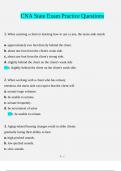Exam (elaborations)
CNA State Exam Practice Questions and Answers 2024/2025
- Module
- NURS MISC (NURSMISC)
- Institution
- Abacus College, Oxford
1. When assisting a client in learning how to use a cane, the nurse aide stands a. approximately two feet directly behind the client. b. about one foot from the client's weak side. c. about one foot from the client's strong side. d. slightly behind the client on the client's weak side >&...
[Show more]



